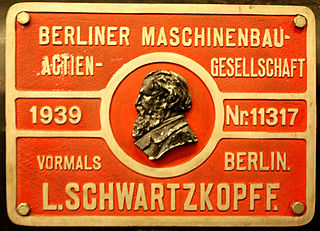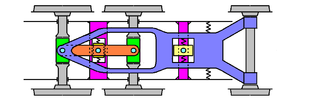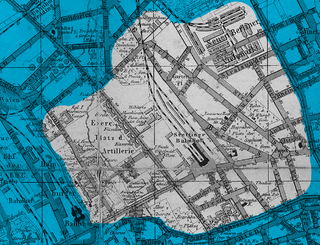
Louis Victor Robert Schwartzkopff (5 June 1825 - 7 March 1892) was a German industrialist and founder of the Berliner Maschinenbau (BMAG) mechanical engineering company, chiefly known as manufacturer of steam locomotives.

Louis Victor Robert Schwartzkopff (5 June 1825 - 7 March 1892) was a German industrialist and founder of the Berliner Maschinenbau (BMAG) mechanical engineering company, chiefly known as manufacturer of steam locomotives.
Louis Schwartzkopff was born in Magdeburg, then capital of the Prussian province of Saxony. Between 1831 and 1842 he attended the grammar school in Magdeburg as well as the trade school there, where he, together with Carl Wilhelm Siemens, studied mathematics under Carl’s brother, Werner von Siemens. From 1842 to 1845 Schwartzkopff attended the trade institute (Gewerbeinstitut) founded by Wilhelm Beuth in Berlin. After that he did his practical training at the firm of Borsig, where he got to know August Borsig personally. Schwartzkopff finished his training with a six-month post as an engine driver on the Berlin-Hamburg Railway. Between 1847 and 1851 he was the chief mechanical engineer (Maschinenmeister) of the Magdeburg-Wittenberge Railway.
With the support of his family he bought the site at Chausseestrasse 20, which was bordered to the south by Invalidenstrasse and to the east by the Berlin-Stettin Railway. Under the terrain of the latter is the underground S-Bahn station called Nordbahnhof.
On 3 October 1852 he founded, together with the then Berliner Gießereimeister Nitsche the Schwartzkopff and Nitsche Iron Foundry & Engineering Works (Eisengießerei and Maschinenfabrik Schwartzkopff and Nitsche) in Berlin, from which the Berliner Maschinenbau AG vorm. L. Schwartzkopff [1] emerged in 1870. Schwartzkopff wanted above all to expand the engineering works, whilst Nitsche preferred to concentrate on artistic castings. So Schwartzkopff bought Nitsche out in 1853 and from then on ran the firm as the only owner. Until 30 June 1888 he was the general manager of the company, but then pulled out of the firm entirely.

The company's production in support of the military and the railway industry resulted, in the 1860s, in Schwartzkopff being granted the title of Kommerzienrat, a historical title conferred on distinguished industrialists or financiers. [2] In 1867, when the production of goods locomotives for the Lower Silesian-Märkische Railway began, Schwartzkopff moved the general engineering side of the business to a newly acquired site in Ackerstrasse, whilst the core business expanded on the previous sites at Chausseestrasse 19 and 23. Schwartzkopff had also acquired the site at Scheringstrasse 13-28 in Berlin-Gesundbrunnen.
At the end of the 1880s Schwartzkopff was appointed to the Council of State for the Prussian Government (Staatsrat der Preußischen Regierung). On 7 March 1892 he died as the result of a stroke. During his life Schwartzkopff always held his master, August Borsig, in high esteem.
Schwartzkopff was curator of the Lazarus Hospital. Schwartzkopffstrasse in Berlin-Mitte was named in his honour on 12 March 1889.
He was buried at the Dorotheenstadt cemetery in Berlin.

Ernst Werner Siemens was a German electrical engineer, inventor and industrialist. Siemens's name has been adopted as the SI unit of electrical conductance, the siemens. He founded the electrical and telecommunications conglomerate Siemens and invented the electric tram, trolley bus, electric locomotive and electric elevator.

Johann Karl Friedrich August Borsig was a German businessman who founded the Borsig-Werke factory.

Berliner Maschinenbau AG was a German manufacturer of locomotives.

Adolf Karl Heinrich Slaby was a German electronics pioneer and the first Professor of electro-technology at Technische Hochschule Charlottenburg.

The Prussian Class P 8 of the Prussian state railways was a 4-6-0 steam locomotive built from 1906 to 1923 by the Berliner Maschinenbau and twelve other German factories. The design was created by Robert Garbe. It was intended as a successor to the Prussian P 6, which was regarded as unsatisfactory.

A Schwartzkopff-Eckhardt bogie is a mechanical device to improve the curve running of steam locomotives.

Emil Julius Carl Kessler was a German businessman and founder of the Maschinenfabrik Esslingen.

The Maschinenbau-Gesellschaft Karlsruhe was a locomotive and railway wagon manufacturer in the early days of the German railways. It was based at Karlsruhe in what is now the state of Baden-Württemberg in southwestern Germany.

The Sächsische Maschinenfabrik in Chemnitz was one of the most important engineering companies in Saxony in the second half of the 19th century and the first two decades of the 20th century. Including its various predecessor businesses, the firm existed from 1837 until its liquidation in 1930, and individual branches of the company taken over by others continued to operate until 1990. The company is closely linked with the name of its founder and long-time manager, Richard Hartmann, whose name formed part of the new company title in 1898: the Sächsische Maschinenfabrik vormals Richard Hartmann.

The Elsässische Maschinenbau-Gesellschaft Grafenstaden was a heavy industry firm located at Grafenstaden in the Alsace, near the city of Strasbourg.
Johann Friedrich Ludwig Wöhlert was a German businessman. Johann Wöhlert was born on 16 September 1797 in Kiel in north Germany. Trained as a joiner, in 1818 Wöhlert went to Berlin. Here he worked until 1836 at the engineering works of Franz Anton Egells and thereafter in the iron foundry and engineering works of August Borsig at Oranienburger Tor.
Friedrich Wilhelm Eckhardt was a German engineer and head of the design office for the Berliner Maschinenbau Aktien Gesellschaft vormals L. Schwartzkopff.

The Dorotheenstadt Cemetery, officially the Cemetery of the Dorotheenstadt and Friedrichswerder Parishes, is a landmarked Protestant burial ground located in the Berlin district of Mitte which dates to the late 18th century. The entrance to the 1.7-hectare (4.2-acre) plot is at 126 Chaussee Straße. It is also directly adjacent to the French cemetery, established in 1780, and is sometimes confused with it.

The Great Industrial Exposition of Berlin 1896 was a large exposition that has also been dubbed "the impeded world fair".

Oranienburger Vorstadt is a historic district of Berlin in what is now the northwestern part of Mitte and the adjacent Gesundbrunnen area, in the modern Mitte borough.
Feuerland was a popular 19th-century designation for the industrial nucleus of Berlin. It was located in the historic Oranienburger Vorstadt section of Berlin in today’s district Berlin-Mitte. The word literally means “land of fire”, but it is also a play on the German name for Tierra del Fuego.

Paul Friedrich Meyerheim was a German painter and graphic artist. He did portraits and landscapes, but is best known as a painter of animals.

Hermann August Jacques Gruson was a German engineer, inventor and industrial entrepreneur.

Richard Lucae was a German architect and from 1873 director of the Berliner Bauakademie.